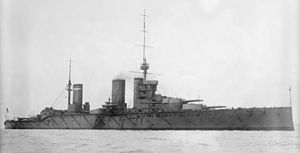HMS Princess Royal (1911)

Princess Royal at anchor
|
|
| History | |
|---|---|
| Name: | Princess Royal |
| Namesake: | The Princess Royal |
| Ordered: | 1909–10 Contingent Programme |
| Builder: | Vickers, Barrow-in-Furness |
| Cost: | £2,076,222 (including armament) |
| Laid down: | 2 May 1910 |
| Launched: | 29 April 1911 |
| Sponsored by: | Princess Louise, The Princess Royal |
| Commissioned: | 14 November 1912 |
| Fate: | Sold for scrap 19 December 1922 |
| General characteristics (as built) | |
| Class and type: | Lion-class battlecruiser |
| Displacement: |
|
| Length: | 700 ft (213.4 m) |
| Beam: | 88 ft 6.75 in (27.0 m) |
| Draught: | 32 ft 5 in (9.9 m) at deep load |
| Installed power: | 70,000 shp (52,200 kW) |
| Propulsion: |
|
| Speed: | 28 knots (52 km/h; 32 mph) |
| Range: | 5,610 nmi (10,390 km; 6,460 mi) at 10 knots (19 km/h; 12 mph) |
| Complement: | 985 (in 1912) |
| Armament: |
|
| Armour: | |
HMS Princess Royal was the second of two Lion-class battlecruisers built for the Royal Navy before World War I. Designed in response to the Moltke-class battlecruisers of the Imperial German Navy, the ships significantly improved on the speed, armament, and armour of the preceding Indefatigable class. The ship was named for The Princess Royal, a title occasionally granted to the Monarch's eldest daughter.
Laid down in 1912 and commissioned in 1913, Princess Royal served in the Battle of Heligoland Bight a month after the war began. She was then sent to the Caribbean to prevent the German East Asia Squadron from using the Panama Canal. After the East Asia Squadron was sunk at the Battle of the Falkland Islands in December 1914, Princess Royal rejoined the 1st Battlecruiser Squadron. During the Battle of Dogger Bank, Princess Royal scored only a few hits, although one crippled the German armoured cruiser Blücher. Shortly afterwards, she became the flagship of the 1st Battlecruiser Squadron, under the command of Rear-Admiral Osmond Brock.
Princess Royal was moderately damaged during the Battle of Jutland and required a month and a half of repairs. Apart from providing distant support during the Second Battle of Heligoland Bight in 1917, the ship spent the rest of the war on uneventful patrols of the North Sea. Princess Royal was placed into reserve in 1920, then was sold for breaking up as scrap in 1922 to meet the terms of the Washington Naval Treaty.
...
Wikipedia
